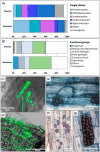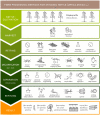Nettle, a Long-Known Fiber Plant with New Perspectives
- PMID: 35744347
- PMCID: PMC9230748
- DOI: 10.3390/ma15124288
Nettle, a Long-Known Fiber Plant with New Perspectives
Abstract
The stinging nettle Urticadioica L. is a perennial crop with low fertilizer and pesticide requirements, well adapted to a wide range of environmental conditions. It has been successfully grown in most European climatic zones while also promoting local flora and fauna diversity. The cultivation of nettle could help meet the strong increase in demand for raw materials based on plant fibers as a substitute for artificial fibers in sectors as diverse as the textile and automotive industries. In the present review, we present a historical perspective of selection, harvest, and fiber processing features where the state of the art of nettle varietal selection is detailed. A synthesis of the general knowledge about its biology, adaptability, and genetics constituents, highlighting gaps in our current knowledge on interactions with other organisms, is provided. We further addressed cultivation and processing features, putting a special emphasis on harvesting systems and fiber extraction processes to improve fiber yield and quality. Various uses in industrial processes and notably for the restoration of marginal lands and avenues of future research on this high-value multi-use plant for the global fiber market are described.
Keywords: Urtica dioica L.; cultivation; fiber production and processing; phylogeny; phytomanagement; stinging nettle.
Conflict of interest statement
The authors declare no conflict of interest.
Figures


 ) and disordered (
) and disordered ( ) process lines for nettle fiber extraction and separation from 1723 until present.
) process lines for nettle fiber extraction and separation from 1723 until present.





References
-
- Hartl A., Vogl C. Dry Matter and Fiber Yields, and the Fiber Characteristics of Five Nettle Clones (Urtica dioica L.) Organically Grown in Austria for Potential Textile Use. Am. J. Altern. Agric. 2002;17:195–200. doi: 10.1079/AJAA200222. - DOI
-
- Bacci L., Baronti S., Predieri S., Di Virgilio N. Fiber Yield and Quality of Fiber Nettle (Urtica dioica L.) Cultivated in Italy. Ind. Crops Prod. 2009;29:480–484. doi: 10.1016/j.indcrop.2008.09.005. - DOI
-
- Harwood J., Horne M., Waldron D. Cultivating Stinging Nettle (Urtica dioica) for Fibre Production in the UK. Asp. Appl. Biol. 2010;101:133–138.
-
- Jankauskienė Z., Gruzdevienė E. Changes in the Productivity of Wild and Cultivated Stinging Nettle (Urtica dioica L.) as Influenced by the Planting Density and Crop Age. Zemdirb. Agric. 2015;102:31–40. doi: 10.13080/z-a.2015.102.004. - DOI
Publication types
Grants and funding
LinkOut - more resources
Full Text Sources

